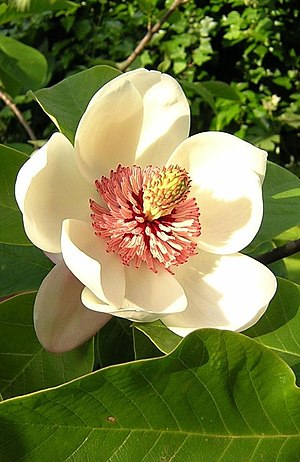Magnolia
| Magnolias | |
|---|---|
 | |
| Genus: | Magnolia |
| Family: | Magnoliaceae |
| Type: | Trees and shrubs |
| Propagation: | Cuttings, grafting |
| Transplant: | Easily transplanted |
Magnolia is a large genus of about 210[1] flowering plant species in the subfamily Magnolioideae of the family Magnoliaceae.
The natural range of Magnolia species is rather scattered. It includes eastern North America, Central America and the West Indies and east and southeast Asia. Some species are found in South America. Today many species of Magnolia and an ever increasing number of hybrids can also be found as ornamental trees in large parts of North America, Europe, Australia and New Zealand. The genus is named after Pierre Magnol, a botanist from Montpellier in France.
Magnolia is an ancient genus. Having evolved before bees appeared, the flowers developed to encourage pollination by beetles. As a result, the carpels of Magnolia flowers are tough, to avoid damage by eating and crawling beetles. Fossilised specimens of M. acuminata have been found dating to 20 million years ago, and of plants identifiably belonging to the Magnoliaceae dating back to 95 million years ago. Another primitive aspect of Magnolias is their lack of distinct sepals or petals. The term tepal has been coined to refer to the intermediate element that Magnolia has instead.
Description
editMagnolias are trees or shrubs, generally with smooth gray bark and suckering freely. The flowers are large, showy, ranging from yellow to white through red and purple. Leaves are simple, often quite large.
Growing conditions
editSpecies
editUses
editIn general, Magnolia is a genus which has attracted a lot of horticultural interest. Hybridisation has been immensely successful in combining the best aspects of different species to give plants which flower at an earlier age than the species themselves, as well as having more impressive flowers. One of the most popular garden magnolias is a hybrid, Magnolia x soulangeana (Saucer magnolia; a hybrid of M. liliiflora x M. denudata).
The bark from M. officinalis has long been used in traditional Chinese medicine, where it is known as houpu. In Japan, M. obovata has been used in a similar manner. The aromatic bark contains magnolol and honokiol, two polyphenolic compounds that have demonstrated anti-anxiety and anti-angiogenic properties. Magnolia bark also has been shown to reduce allergic and asthmatic reactions.
Maintenance
editPropagation
editHarvesting
editPests and diseases
edit- Irene araliae
- Meliola amphitrichia
- Meliola magnoliae
- Trichodothis comata
- Pellicularia koleroga
- Alternaria tenuis, Cladosporium fasciculatum, Colletotrichum spp., Coniothyrium olivaceum, Epicoccum nigrum, Exophoma magnoliae, Glomerella cingulata, Hendersonia magnoliae, Micropeltis alabamensis, Mycosphaerella milleri, Phyllosticta cookei, Phyllosticta glauca, Phyllosticta magnoliae, Septoria magnoliae, and Septoria niphostoma
- Phomopsis spp.
Cankers Nectria magnoliae Leaf Scab
- Elsinoe magnoliae, Sphaceloma magnoliae
- Fomes geotropus, Fomes fasciatus
Angular Leaf Spot
- Mycosphaerella milleri
Algal Spot: Cephaleuros virescens
- Tuliptree Aphid: Macrosiphium liriodendri
- California Red Scale: Aonidiella aurantii
- Oleander Scale: Aspidiotus nerii
- Oleander Pit Scale: Asterolecanium pustulans
- Indian Wax Scale: Ceroplastes ceriferus
- Florida Wax Scale: Ceroplastes floridensis
- Greedy Scale: Hemiberlesia rapax
- Cottony Cushion Scale: Icerya purchasi
- Magnolia Scale: Neolecanium cornuparvum
- European Fruit Lecanium Scale: Lecanium corni
- Common Falsepit Scale: Lecanodiaspis prosopidis
- Glover Scale: Lepidosaphes gloveri
- Purple Scale: Lepidosaphes beckii
- Chaff Scale: Parlatoria pergandii
- Fern Scale: Pinnaspis aspidistrae
- False Oleander Scale: Pseudaulacapsis cockerelli
- Tuliptree Scale: Toumeyella liriodendri
- Black Scale: Saissetia oleae
- Citrus Whitefly: Dialeurodes citri
- Striped Mealybug: Ferrisia virgata
- Comstock Mealybug: Pseudococcus comstocki
- Greenhouse Thrips: Heliothrips haemorrhoidalis
- Hoplia Beetle: Hoplia callipyge
- Black Twig Borer: Xylosandrus compactus
- Asian Ambrosia Beetle: Xylosandrus germanus
- Sassafras Weevil (Yellow Poplar Weevil): Odontopus calceatus
- Omnivorous Looper Caterpillars: Sabulodes aegrotata, Sabulodes caberata
- Promethea Moth: Callosamia promethia
- Eastern Tiger Swallowtail: Papilio glaucus
Gallery
edit-
The seeds are exposed when the fruit splits open.
-
Magnolia x soulangeana flower.
-
Flower of a Magnolia Tree
References
edit- Treseder, N.G. (1978). Magnolias. London/Boston, Faber & Faber. ISBN 0-571-09619-0
- Callaway, D.J. (1994). The world of Magnolias. Portland, Oregon, Timber Press. ISBN 0-88192-236-6
- Hunt, D. (ed). (1998). Magnolias and their allies. International Dendrology Society & Magnolia Society. ISBN 0-9517234-8-0
- Law, Y.W. (= Liu, Y.H.) (2004). Magnolias of China. Hong-Kong, Beijing Science & Technology Press. ISBN 7-5304-2765-2
- Flora of China: Magnoliaceae (draft account)
- Magnolia Society
- ↑ The number of species in the genus Magnolia depends on the taxonomic view that one takes up. Recent molecular and morphological research shows that former genera Talauma, Dugandiodendron, Manglietia, Michelia, Elmerrillia, Kmeria, Parakmeria, Pachylarnax (and a small number of monospecific genera) all belong within the same genus, Magnolia s.l. (s.l. = sensu lato: 'in a broad sense', as opposed to s.s. = sensu stricto: 'in a narrow sense'). The genus Magnolia s.s. contains about 120 species.